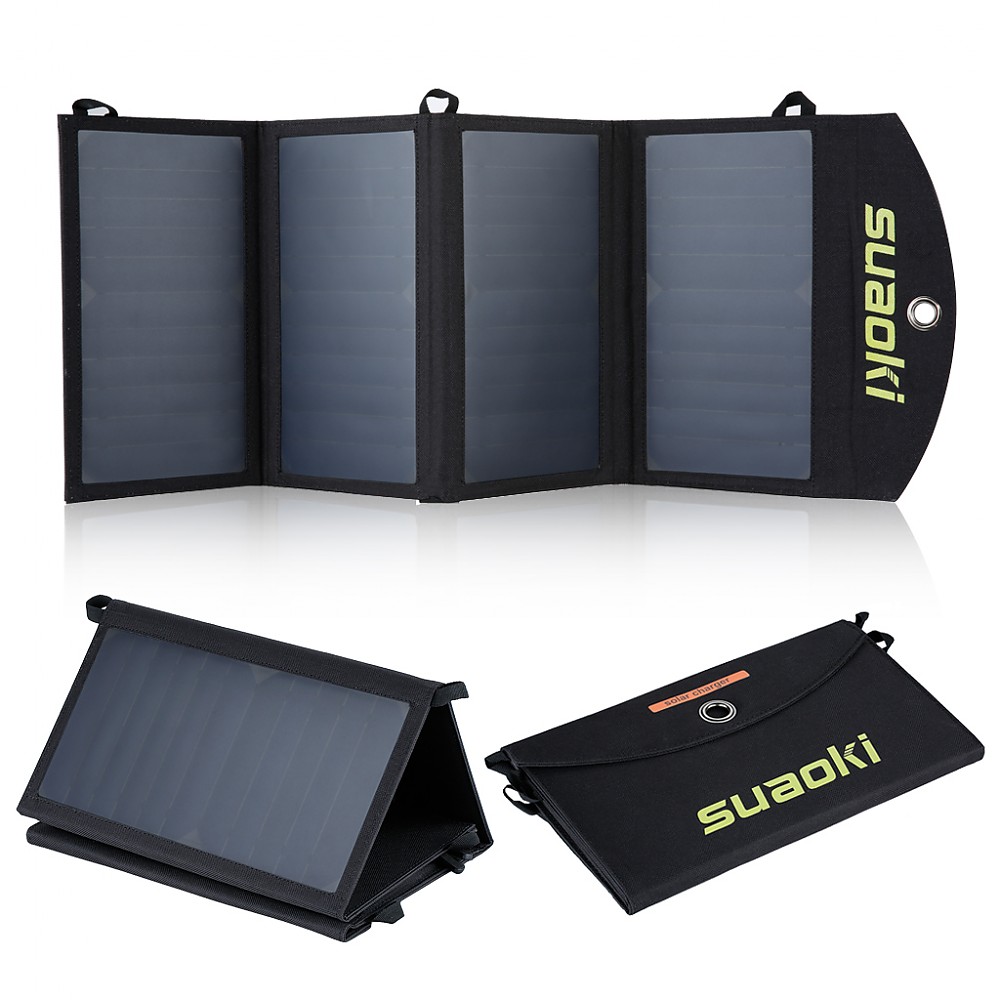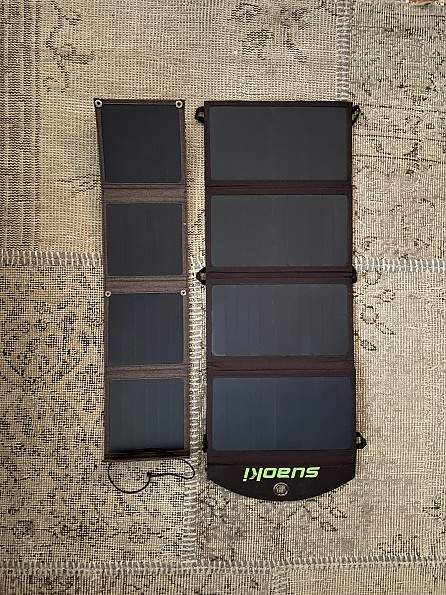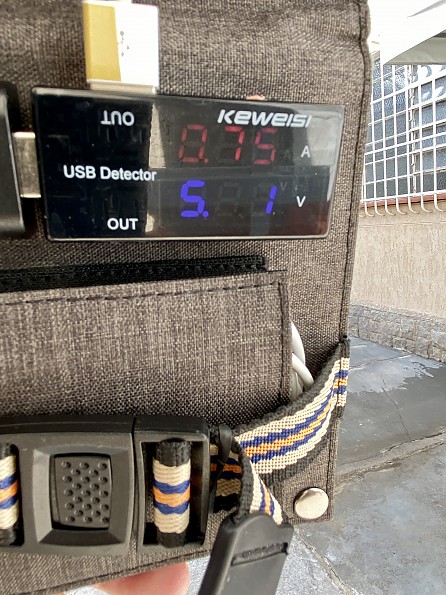Suaoki 25W Foldable Solar Panel

A dependable, versatile, and efficient compact solar panel perfect for backpacking, camping, and longer explorations in the wilderness. I’m not sure it’s still available, but if you find one second-hand in good shape, test it before committing to purchase.
Pros
- Well built
- Durable
- Efficient
- Smart charging detects device parameters
- Has two USB ports
- LED light indicates charging state
- Multiple hanging points and modes
- Hasn’t lost efficiency with time and use
Cons
- QC seem a bit hit-or-miss when it comes to functioning (it shows early and other panels also suffer from this too)
- Heavy @ 26oz/750g
- Won’t charge DCs even with converters (but to be fair most others in this capacity won’t either)
- Not sure it’s still available
The market for portable, eco-friendly solar charging solutions has grown by leaps and bounds in the last decade. Suaoki was established in 2015 and is one of the many companies dedicated exclusively to this.
I see this renewable energy technology as complementary, as a personal option for powering up smaller electronics vital for our personal use (communication, life support, etc.) and also as tools for prepping and survivalism. In the field (i.e. outdoor activities like camping, backpacking, training, etc.) it’s perhaps the only way. I put this in context and talk about that and other contemporary energy issues in more detail in an article I wrote for the blog The Organic Prepper. For these uses panels like these can be efficient.
This panel as well as other Suaoki models were available until around 2019/2020 new from many sources, but I’m not sure if it’s still being made. Demand for renewable energy has increased a lot since 2020 cv19 and other brands have entered the market. I couldn’t find it on Amazon or even at Suaoki’s website. It felt to me that they’re moving towards higher-capacity (over 100W) portable systems with DC capability and battery banks. Or maybe it’s just the shortage of components like microchips and stuff.
It is still possible to find new and used for sale on the internet though, at least in some markets. There are plenty alternatives out there around this 25-30W mark, some really good ones, but if you decide to shop for a used one be sure to have it tested (by yourself or a video from the seller or something) before taking the plunge. Some units are pristine and failures/faults usually show early (which prompted Suaoki customer service to replace in most instances according to my research).
The Suaoki 25W was my first mid-power, high-efficiency (20-25% transition efficiency) solar panel. I own another 14W/single port from them and both work perfectly since the start. I use both for daily activities, the small one usually stays in my bag 24/7 and the 25W presented here goes to the wilderness when I need more capacity. Bellow, both panels side-by-side for size comparison.

Below I show pictures of both in action at home during a sunny autumn morning, clear sky, charging the same iPhone used to take the shots. The digital reader shows the voltage (blue) and amperage (red) on each while charging the phone. Amperage tends to increase shortly after connection, staying around the advertised 2A for USB port if the sky is clear, while voltage also remains stable at ~5V as promised.


The amperage and voltage do fluctuate in cloudy conditions, or when going through shadows. Sometimes it will resume full powering automatically, but on occasion it may demand a disconnect-reconnect of cables to go back to full charge mode when it’s back to light. The red LED inside the pouch will blink if charge has been interrupted os is bellow accepted. The small 14W has a green LED instead.
I admit this can be bothersome and will demand frequent checking to see if it’s charging, but most other similar panels I’ve used or tested also require constant attention when not in ideal conditions (i.e. clear skies and bright sun). Larger kits with more complex charging/energy managing systems can overcome that but they’re not as remotely portable. You learn to live with this.
In perfect to near-perfect conditions, both panels are pretty quick to charge devices such as smartphones, flashlights, headlamps, lanterns, tablets, earbuds, and even larger gadgets like laptops and others. I have USB 5V to 12V converters to try and charge DC pieces like HT radios and such, but I’ve found that it only works with 50W panels and above. Neither the 14W nor the 25W solar shown here are capable of that. I was able to charge 7V and 8V DC appliances with the 25W though so this seems to be a hit-or-miss feature and I don’t count on it.
I have found a way to go around this by using a couple of Olight UBC’s (Universal battery Chargers) to charge individual AA, AAA, 18650 and CR123A and others individually, using the solar panels, then using those into the devices. I love these. These little wonders are amazing and do an excellent job of charging almost all kinds of rechargeables and pretty fast. They’re magnetic, auto detecting (polarity) and stay neatly inside the pocket. Sure it’s an overall slow and rather painstaking process to charge everything like that but if time not an issue, it works and is reliable. This allows the use of any battery with the solar panels.
The Suaoki works in less than idea conditions, but as expected it will slow everything down and depending on the light available, it will shut down entirely and requires a “reboot”. I‘ve found, like most other frequent users maybe, that the most effective way of using portable solar panels is to charge power banks during the day (or whenever light is available and plentiful), then using the PBs to charge the devices when I’m pausing or during the night.
I do use it to charge devices directly but that’s more effective and straightforward IMHO. PBs are very practical and reliable indeed. I know this demands carrying extra pounds in form of one or two 15.000-20.000 high-efficiency (80%) powerbanks, but I feel that PBs are needed for outdoor and emergency activities and training anyway so what to do.
Bottom line is, the 25W Suaoki is a good option for personal, portable solar charging. There are now a ton of others in the market. It‘s not perfect, but it’s well built, is conversion efficiency rate is already around the near-maximum for solar panels (showing it’s still a modern device), it can take some abuse and although it’s heavy per se, this is a feature of such kits and not exactly a con. I’ve adapted its qualities and shortcomings to my routine and what really matters to me it’s reliability and consistency, and the Suaoki has been delivering both for years to me so I’m sticking with it until it fails (hoping it doesn’t!).
Background
I like experimenting with electronics and solar panels and have been messing with this stuff for some time, retrofitting small cells taken from toys and gadgets into other appliances like battery charges and similars. Since these cool solar panels started coming out, I took a few of different capacities and various brands to use and test, trying to follow the development of the tech and the advancements made. The best ones are still quite heavy IMHO, but are now highly efficient.
Source: bought it new
Price Paid: Around USD 100 for the 25W because of importing fees and all.
This video is a review of our foldable solar panel Suaoki 25W and us sharing some tips on how we keep all of our electronics charged while hiking and backpacking in the wilderness.
We are going to talk about the technical specs of it, its features, how efficient and resistant it really is, and overall how we use it and our thoughts about it after three years of active use.
How you keep your electronics charged and what kind of solar panel you use?
Disclaimer: We don't have any affiliation with the brands and all items mentioned in videos were purchased by our own money.
Source: bought it new



